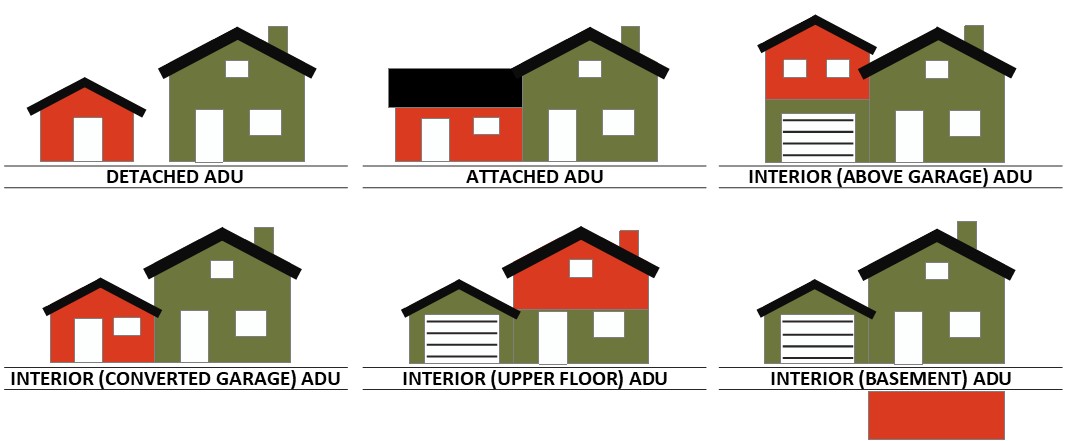An Accessory Dwelling Unit, is a smaller, independent residential dwelling unit located on the same lot as a stand-alone (i.e., detached) single-family home.
 As of Monday, August 5th, 2024 the City of Topeka passed an ordinance allowing for Accessory Dwelling Units in all single-family zoning districts (R-1, R-2, and R-3). The passing of this ordinance followed nearly two years of public input and meeting with key stakeholders. Now within the single-family zoning districts a new subordinate unit is allowed on a single zoning lot, increasing the supply of housing choices and providing property owners greater ability to generate revenue. Below the ordinance, text amendment and previous presentation to the Governing Body can be found.
As of Monday, August 5th, 2024 the City of Topeka passed an ordinance allowing for Accessory Dwelling Units in all single-family zoning districts (R-1, R-2, and R-3). The passing of this ordinance followed nearly two years of public input and meeting with key stakeholders. Now within the single-family zoning districts a new subordinate unit is allowed on a single zoning lot, increasing the supply of housing choices and providing property owners greater ability to generate revenue. Below the ordinance, text amendment and previous presentation to the Governing Body can be found.
 As of Monday, August 5th, 2024 the City of Topeka passed an ordinance allowing for Accessory Dwelling Units in all single-family zoning districts (R-1, R-2, and R-3). The passing of this ordinance followed nearly two years of public input and meeting with key stakeholders. Now within the single-family zoning districts a new subordinate unit is allowed on a single zoning lot, increasing the supply of housing choices and providing property owners greater ability to generate revenue. Below the ordinance, text amendment and previous presentation to the Governing Body can be found.
As of Monday, August 5th, 2024 the City of Topeka passed an ordinance allowing for Accessory Dwelling Units in all single-family zoning districts (R-1, R-2, and R-3). The passing of this ordinance followed nearly two years of public input and meeting with key stakeholders. Now within the single-family zoning districts a new subordinate unit is allowed on a single zoning lot, increasing the supply of housing choices and providing property owners greater ability to generate revenue. Below the ordinance, text amendment and previous presentation to the Governing Body can be found.
The City of Topeka Planning Division is continuing to explore ways to incentive this type of housing within City limits.
What is Missing Middle Housing?
Missing middle housing is defined as any property with two (2) to twenty (20) dwelling units. These housing types are often referred to has hidden density, as they can provide a greater housing supply on a smaller foot-print than garden apartments or high rise apartments. During the 2020 City-wide Housing Study, this type of housing was identified as one of the least found housing types, with demand greatly exceeding the supply. One path the City of Topeka is exploring to increase the housing supply is to allow duplexes, triplexes, or quadplexes in single-family zoning districts.More Information
The passing of the ADU ordinance was the first policy reform completed as part of the Missing Middle Code Amendments, but just a first step to increase the quantity of missing middle housing. Additional policies that are being explored relate to:
- Parking Requirements
- Dimensional Standards within Residential Zoning Districts.
- Housing Incentives
Parking
is often a cost that is handed down to renters following the development process. Current parking standards generally require two (2) parking spots for every unit, creating a challenge for developable sites to incorporate required parking and a quantity of units that provide a profit. By loosening these standards, a significant number of parcels have an easier path to development.Dimensional Standards within Residential Zoning Districts and Housing Incentives
The documents below are related to dimensional standards and incentives presented at the August 19, 2024 Planning Commission Meeting. https://topekaspeaks.org/?body=planning-commissionDuplexes, tri-plexes, and four-plexes in "R" residential Districts
The City of Topeka's Planning Commission Incentives Committee is proposing changes to Topeka's Zoning regulations to allow duplexes, tri-plexes, and four plexes in "R" residential districts. A survey has been distributed through City of Topeka channels to receive input from the public prior to making any policy changes. Changing these standards would allow for more housing options to developers and more supply to residents. The survey will only be open until February 21st.
